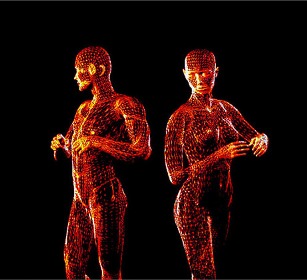People with balanced bodies are more attractive in the eyes of the opposite sex
According to scientists, when considering you, the human assessment of the physical beauty is primarily about balance.
A new study finds that the more balanced a person's body is, the more attractive he is to the opposite sex.
By using headless 3D models, the researchers found that balanced bodies are more attractive to opposite sexes and they also find feminine or stolen traits associated with balance .
In an article published in August 2008, scientists believe that humans may have been controlled in response to the body's balance as a sign of biological fit.
Previous studies have shown that faces with harmonious traits are considered beautiful, which partly confirms the view that the ancient Greeks suggested that symmetry is one of the important factors. in human evaluation of beauty.
The study also found similarity to the body's balance, symmetry can be a sign of biological suitability.
A member of the Willian Brown research group at Brunel University in the United Kingdom said: 'Naturally selected animals give two symmetrical parts, the development of symmetrical axis deviations represent weak qualities or due to living in environmental or genetic pressure '.
'In many species, axial development is often associated with poor health, poor survival and few children'.
The study is detailed in the issue this week in the Proceedings of the National Academy of Sciences.

Subtle balance
By using a 3D optical scanner similar to that used in the medical and fashion industry, Brown and his colleagues have created a detailed virtual body model of 77 adults. at the same time determine the level of balance of the models.
Researchers later asked another group of 87 volunteers to assess the attractiveness of other sensory bodies based on superficial attraction.
To avoid prejudices of face characteristics or skin color, the head of the virtual models is removed and all body models are painted in the same neutral color.
Although differences in right-to-left symmetry can be observed with the naked eye, both men and women think that symmetrical bodies are more attractive.
Similarly, more balanced women often have more characteristic feminine characteristics, such as larger hips, longer and slender legs or larger breasts.
In an earlier study, Brown and his team found that people with more balanced bodies were often better dancers, which may indicate that the ability to dance is a special way of promoting. Physical points.
Brown said: 'It seems that the disproportionate characteristics of the body are difficult to detect with the naked eye, the fact that evolution has designed visible signs or manifestations, such as broad shoulders and waist lines. slender, or smooth steps - to show qualities'.
Objective method
John Manning - evolutionary psychologist of Lancashire University - stressed that in most cases the difference between the left and right of the human body is very small, only about 1% to 3% .
Therefore, previous studies using external measurement to measure the symmetry of the body are easy to make mistakes in the process of taking measurements.
In contrast, 3D scanners offer a different way to determine the symmetry of the body.
The new study also provides evidence of a link between body symmetry and the physical characteristics of the body.
Manning said: 'This means that if a woman is paired with a man with a strong body or a man who chooses a woman with a feminine body, they seem to have found a person with all relevant benefits related '.
- Attractive speakers have a more balanced body
- Muscular men will live longer
- Science reveals more glamorous moves without a salon
- Why wear sunglasses that make people look more attractive?
- Strange possibilities of eyes
- Interesting discovery about the human body
- The mystery of eyes 'killing people with just one look'
- 19 most obsessive eyes in the history of world photography
- 'A balanced meal' to stay healthy
- People use fluent eyes language from birth
- Smile is your most attractive feature
- Fifty facts about eyes
 'Fine laughs' - Scary and painful torture in ancient times
'Fine laughs' - Scary and painful torture in ancient times The sequence of numbers 142857 of the Egyptian pyramids is known as the strangest number in the world - Why?
The sequence of numbers 142857 of the Egyptian pyramids is known as the strangest number in the world - Why? History of the iron
History of the iron What is alum?
What is alum?